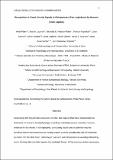Files in this item
Recognition of visual kinship signals in chimpanzees (Pan troglodytes) by humans (Homo sapiens)
Item metadata
| dc.contributor.author | Péter, Hella | |
| dc.contributor.author | Laporte, Marion | |
| dc.contributor.author | Newton-Fisher, Nicholas E. | |
| dc.contributor.author | Reynolds, Vernon | |
| dc.contributor.author | Samuni, Liran | |
| dc.contributor.author | Soldati, Adrian | |
| dc.contributor.author | Vigilant, Linda | |
| dc.contributor.author | Villioth, Jakob | |
| dc.contributor.author | Graham, Kirsty E. | |
| dc.contributor.author | Zuberbühler, Klaus | |
| dc.contributor.author | Hobaiter, Catherine | |
| dc.date.accessioned | 2022-11-24T12:30:25Z | |
| dc.date.available | 2022-11-24T12:30:25Z | |
| dc.date.issued | 2022-11-30 | |
| dc.identifier | 282185834 | |
| dc.identifier | 7badf1eb-a261-4751-9ee3-c023c0109c0e | |
| dc.identifier | 000878771700001 | |
| dc.identifier | 85144094347 | |
| dc.identifier.citation | Péter , H , Laporte , M , Newton-Fisher , N E , Reynolds , V , Samuni , L , Soldati , A , Vigilant , L , Villioth , J , Graham , K E , Zuberbühler , K & Hobaiter , C 2022 , ' Recognition of visual kinship signals in chimpanzees ( Pan troglodytes ) by humans ( Homo sapiens ) ' , Journal of Comparative Psychology , vol. 136 , no. 4 , pp. 255-269 . https://doi.org/10.1037/com0000327 | en |
| dc.identifier.issn | 0735-7036 | |
| dc.identifier.other | crossref: 10.1037/com0000327 | |
| dc.identifier.other | ORCID: /0000-0002-7422-7676/work/123195650 | |
| dc.identifier.other | ORCID: /0000-0001-8378-088X/work/123195663 | |
| dc.identifier.other | ORCID: /0000-0002-3893-0524/work/123195700 | |
| dc.identifier.uri | https://hdl.handle.net/10023/26483 | |
| dc.description | Funding: The authors thank the Royal Zoological Society Scotland for the core funding they provide to the Budongo Conservation Field Station. | en |
| dc.description.abstract | Associating with kin provides individual benefits but requires that these relationships be detectable. In humans, facial phenotype matching might help assess paternity; however, evidence for it is mixed. In chimpanzees, concealing visual cues of paternity may be beneficial due to their promiscuous mating system and the considerable risk of infanticide by males. On the other hand, detecting kin can also aid chimpanzees in avoiding inbreeding and in forming alliances that improve kin-mediated fitness. Although previous studies assessing relatedness based on facial resemblance in chimpanzees exist, they used images of captive populations in whom selection pressures and reproductive opportunities are controlled and only assessed maternity or paternity of adult offspring. In natural populations, the chances of infanticide are highest during early infancy, suggesting that young infants would benefit most from paternity concealment, whereas adults and subadults would benefit from the detection of all types of kin, including half-siblings. In our experiment, we conducted an online study with human participants, in which they had to assess the relatedness of chimpanzees based on facial similarity. To address previous methodological constraints, we used chimpanzee images across all ages, as well as maternal and paternal half-siblings. We found that kin status was detected above chance across all relatedness categories, with easier kin detection of father-offspring pairs, females, and older chimpanzees. Together, these findings support the existence of paternity confusion in infant chimpanzees and provide a possible mechanism for incest avoidance and kin-based social alliances in older individuals. | |
| dc.format.extent | 15 | |
| dc.format.extent | 512334 | |
| dc.language.iso | eng | |
| dc.relation.ispartof | Journal of Comparative Psychology | en |
| dc.subject | Kin selection | en |
| dc.subject | Kin recognition | en |
| dc.subject | Facial resemblance | en |
| dc.subject | Chimpanzee | en |
| dc.subject | BF Psychology | en |
| dc.subject | DAS | en |
| dc.subject | AC | en |
| dc.subject | MCC | en |
| dc.subject.lcc | BF | en |
| dc.title | Recognition of visual kinship signals in chimpanzees (Pan troglodytes) by humans (Homo sapiens) | en |
| dc.type | Journal article | en |
| dc.contributor.institution | University of St Andrews. School of Psychology and Neuroscience | en |
| dc.contributor.institution | University of St Andrews. Institute of Behavioural and Neural Sciences | en |
| dc.contributor.institution | University of St Andrews. Centre for Social Learning & Cognitive Evolution | en |
| dc.identifier.doi | https://doi.org/10.1037/com0000327 | |
| dc.description.status | Peer reviewed | en |
This item appears in the following Collection(s)
Items in the St Andrews Research Repository are protected by copyright, with all rights reserved, unless otherwise indicated.

